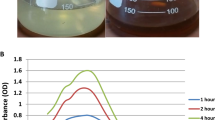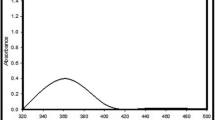Abstract
Green route for silver nanoparticle synthesis has gained increasing attention. Cyanobacteria are one of the promising organisms to produce a number of secondary metabolites that are capable of reducing silver ions to small-sized silver nanoparticles. In the present study, we employed an aqueous extract of the cyanobacterium Haloleptolyngbya alcalis KR2005/106 isolated from a soda lake for biosynthesis of silver nanoparticles (AgNPs). The extract acted as a reducing agent for AgNPs synthesis and resulted formation of nanoparticles < 50 nm in size. In this study, synthesis of AgNPs obtained only in the sample exposed to photosynthetically active radiation (PAR) while the synthesis of AgNPs was not observed in the samples kept in dark. The biogenic fabrication of AgNPs was carried out by optimizing several governing parameters such as concentration of the silver nitrate solution, pH, temperature, and amount of biomass. Results obtained through different analytical techniques revealed that cyanobacterial taxon H. alcalis isolated from saline-alkaline habitat is a potential candidate for biosynthesis of optimum-sized spherical AgNPs. Surface plasmon resonance (SPR) property of AgNPs was exploited for aqueous ammonia sensing and revealed that AgNPs synthesized using aqueous extract of cyanobacterium H. alcalis could be employed for colorimetric detection of dissolved ammonia for monitoring quality of water.




Similar content being viewed by others
References
Amirjani A, Fatmehsari DH (2018) Colorimetric detection of ammonia using smartphones based on localized surface plasmon resonance of silver nanoparticles. Talanta 176:242–246
Baun A, Hartmann NB, Grieger K, Kusk KO (2008) Ecotoxicity of engineered nanoparticles to aquatic invertebrates: a brief review and recommendations for future toxicity testing. Ecotoxicology 17(5):387–395
Besar K, Dailey J, Zhao X, Katz HE (2017) A flexible organic inverter made from printable materials for synergistic ammonia sensing. J Mater Chem C 5(26):6506–6511
Birla SS, Gaikwad SC, Gade AK, Rai MK (2013) Rapid synthesis of silver nanoparticles from Fusarium oxysporum by optimizing physicocultural conditions. Sci World J 2013:1–12
Chernousova S, Epple M (2013) Silver as antibacterial agent: ion, nanoparticle, and metal. Angew Chemie Int Ed 52(6):1636–1653
Cho YB, Jeong SH, Chun H, Kim YS (2018) Selective colorimetric detection of dissolved ammonia in water via modified Berthelot’s reaction on porous paper. Sensors Actuators B Chem 256:167–175
Dadheech PK, Mahmoud H, Kotut K, Krienitz L (2012) Haloleptolyngbya alcalis gen. et sp. nov., a new filamentous cyanobacterium from the soda lake Nakuru, Kenya. Hydrobiologia 691(1):269–283
Das J, Das MP, Velusamy P (2013) Sesbania grandiflora leaf extract mediated green synthesis of antibacterial silver nanoparticles against selected human pathogens. Spectrochim Acta Part A Mol Biomol Spectrosc 104:265–270
Dubas ST, Pimpan V (2008) Green synthesis of silver nanoparticles for ammonia sensing. Talanta 76(1):29–33
El-Naggar NE-A, Abdelwahed NAM (2014) Application of statistical experimental design for optimization of silver nanoparticles biosynthesis by a nanofactory Streptomyces viridochromogenes. J Microbiol 52(1):53–63
El-Naggar NE-A, Hussein MH, El-Sawah AA (2017) Bio-fabrication of silver nanoparticles by phycocyanin, characterization, in vitro anticancer activity against breast cancer cell line and in vivo cytotxicity. Sci Rep 7(1):10844
Garg S (2012) Rapid biogenic synthesis of silver nanoparticles using black pepper (Piper nigrum) corn extract. Int J Innov Biol Chem Sci 3:5–10
Ghauch A, Rima J, Charef A, Suptil J, Fachinger C, Martin-Bouyer M (1999) Quantitative measurements of ammonium, hydrogenophosphate and Cu (II) by diffuse reflectance spectrometry. Talanta 48:385–392
Gurunathan S (2015) Biologically synthesized silver nanoparticles enhances antibiotic activity against Gram-negative bacteria. J Ind Eng Chem 29:217–226
Gurunathan S, Kalishwaralal K, Vaidyanathan R, Venkataraman D, Pandian SRK, Muniyandi J, Hariharan N, Eom SH (2009) Biosynthesis, purification and characterization of silver nanoparticles using Escherichia coli. Colloids Surf B Biointerfaces 74(1):328–335
Husain S, Sardar M, Fatma T (2015) Screening of cyanobacterial extracts for synthesis of silver nanoparticles. World J Microbiol Biotechnol 31(8):1279–1283
Iravani S (2014) Bacteria in nanoparticle synthesis: current status and future prospects. Int Sch Res Notices 2014:359316
Lengke MF, Fleet ME, Southam G (2007) Biosynthesis of silver nanoparticles by filamentous cyanobacteria from a silver (I) nitrate complex. Langmuir 23(5):2694–2699
Li RCC, Chan PCH, Cheung PW (1995) Analysis of a MOS integrated gas sensor using a surface chemistry based model. Sensors Actuators B Chem 28(3):233–242
Link S, El-Sayed MA (2000) Shape and size dependence of radiative, non-radiative and photothermal properties of gold nanocrystals. Int Rev Phys Chem 19(3):409–453
Malins C, Doyle A, MacCraith BD et al (1999) Personal ammonia sensor for industrial environments. J Environ Monit 1(5):417–422
Mesbah NM, Wiegel J (2012) Life under multiple extreme conditions: diversity and physiology of the halophilic alkalithermophiles. Appl Environ Microbiol 78(12):4074–4082
Mie G (1908) Contributions to the optics of cloudy media, especially colloidal metal solutions. Ann Phys 330(3):377–445
Morsy FM, Nafady NA, Abd-Alla MH, Elhady DA (2014) Green synthesis of silver nanoparticles by water soluble fraction of the extracellular polysaccharides/matrix of the cyanobacterium Nostoc commune and its application as a potent fungal surface sterilizing agent of seed crops. Univ J Microbiol Res 2(2):36–43
Mukherjee S, Chowdhury D, Kotcherlakota R, Patra S (2014) Potential theranostics application of bio-synthesized silver nanoparticles (4-in-1 system). Theranostics 4(3):316–335
Nayak D, Pradhan S, Ashe S, Rauta PR, Nayak B (2015) Biologically synthesised silver nanoparticles from three diverse family of plant extracts and their anticancer activity against epidermoid A431 carcinoma. J Colloid Interface Sci 457:329–338
Naz S, Khaskheli AR, Aljabour A, Kara H, Talpur FN, Sherazi STH, Khaskheli AA, Jawaid S (2014) Synthesis of highly stable cobalt nanomaterial using gallic acid and its application in catalysis. Adv Chem 2014:1–6
Ostrensky A, Wasielesky W Jr (1995) Acute toxicity of ammonia to various life stages of the São Paulo shrimp, Penaeus paulensis Pérez-Farfante, 1967. Aquaculture 132(3–4):339–347
Pandey S, Goswami GK, Nanda KK (2012) Green synthesis of biopolymer–silver nanoparticle nanocomposite: an optical sensor for ammonia detection. Int J Biol Macromol 51(4):583–589
Pant G, Nayak N, Prasuna RG (2013) Enhancement of antidandruff activity of shampoo by biosynthesized silver nanoparticles from Solanum trilobatum plant leaf. Appl Nanosci 3(5):431–439
Patel V, Berthold D, Puranik P, Gantar M (2015) Screening of cyanobacteria and microalgae for their ability to synthesize silver nanoparticles with antibacterial activity. Biotechnol Rep 5:112–119
Patra JK, Baek K-H (2014) Green nanobiotechnology: factors affecting synthesis and characterization techniques. J Nanomater 2014:1–12
Prathna TC, Chandrasekaran N, Raichur AM, Mukherjee A (2011) Biomimetic synthesis of silver nanoparticles by Citrus limon (lemon) aqueous extract and theoretical prediction of particle size. Colloids Surf B Biointerfaces 82(1):152–159
Rippka R, Deruelles J, Waterbury JB et al (1979) Generic assignments, strain histories and properties of pure cultures of cyanobacteria. J Gen Microbiol 111:1–61
Ritthichai T, Pimpan V (2017) Ammonia sensing of silver nanoparticles synthesized using tannic acid combined with UV radiation: effect of UV exposure time. J King Saud Univ Sci 1:1–8
Rösken LM, Körsten S, Fischer CB et al (2014) Time-dependent growth of crystalline Au0-nanoparticles in cyanobacteria as self-reproducing bioreactors: 1. Anabaena sp. J Nanopart Res 16(4):1–14
Roy K, Sarkar CK, Ghosh CK (2015) Photocatalytic activity of biogenic silver nanoparticles synthesized using potato (Solanum tuberosum) infusion. Spectrochim Acta A Mol Biomol Spectrosc 146:286–291
Roychoudhury P, Ghosh S, Pal R (2016) Cyanobacteria mediated green synthesis of gold-silver nanoalloy. J Plant Biochem Biotechnol 25:73–78
Saranyaadevi K, Subha V, Ravindran RSE, Renganathan S (2014) Green synthesis and characterization of silver nanoparticle using leaf extract of Capparis zeylanica. Asian J Pharm Clin Res 7:44–48
Satapathy S, Shukla SP (2017) Application of a marine cyanobacterium Phormidium fragile for green synthesis of silver nanoparticles. Indian J Biotechnol 16:110–113
Schröfel A, Kratošová G, Šafařík I, Šafaříková M, Raška I, Shor LM (2014) Applications of biosynthesized metallic nanoparticles–a review. Acta Biomater 10(10):4023–4042
Shivaji S, Madhu S, Singh S (2011) Extracellular synthesis of antibacterial silver nanoparticles using psychrophilic bacteria. Process Biochem 46(9):1800–1807
Singh R, Shedbalkar UU, Wadhwani SA, Chopade BA (2015) Bacteriagenic silver nanoparticles: synthesis, mechanism, and applications. Appl Microbiol Biotechnol 99(11):4579–4593
Singh AK, Tiwari R, Kumar V et al (2017) Photo-induced biosynthesis of silver nanoparticles from aqueous extract of Dunaliella salina and their anticancer potential. J Photochem Photobiol B Biol 166:202–211
Sivalingam MM, Balasubramanian K (2017) Influence of the concentration of reducing agent on gold nanoparticles decorated reduced graphene oxide and its ammonia sensing performance. Appl Phys A Mater Sci Process 123(4):281
Sonker A, Pathak J, Kannaujiya V, Sinha R (2017) Characterization and in vitro antitumor, antibacterial and antifungal activities of green synthesized silver nanoparticles using cell extract of Nostoc sp. strain HKAR-2. Can J Biotechnol 1:26–37
Srivastava V, Jain K (2015) Mechanism of enhancement in NH 3 sensing for surface functionalized WO 3 film. RSC Adv 5(70):56993–56997
Sudha SS, Rajamanickam K, Rengaramanujam J (2013) Microalgae mediated synthesis of silver nanoparticles and their antibacterial activity against pathogenic bacteria. Indian J Exp Biol 52:393–399
Suvith VS, Philip D (2014) Catalytic degradation of methylene blue using biosynthesized gold and silver nanoparticles. Spectrochim Acta A Mol Biomol Spectrosc 118:526–532
Tang Y-L, Li Z-J, Ma J-Y, Su HQ, Guo YJ, Wang L, du B, Chen JJ, Zhou W, Yu QK, Zu XT (2014) Highly sensitive room-temperature surface acoustic wave (SAW) ammonia sensors based on Co3O4/SiO2 composite films. J Hazard Mater 280:127–133
Timmer B, Olthuis W, Van Den Berg A (2005) Ammonia sensors and their applications—a review. Sensors Actuators B Chem 107(2):666–677
Vanlalveni C, Rajkumari K, Biswas A et al (2018) Green synthesis of silver nanoparticles using Nostoc linckia and its antimicrobial activity: a novel biological approach. BioNanoScience 8(2):624–631
Vasquez RD, Apostol JG, de Leon JD et al (2016) Polysaccharide-mediated green synthesis of silver nanoparticles from Sargassum siliquosum JG Agardh: assessment of toxicity and hepatoprotective activity. OpenNano 116–24
Wei N, Hou Y, Lu Z, Yu H, Wang Q (2018) Synthesis of silver nanoparticles stabilized with C-phycocyanin and for fluorimetric detection of copper ions. IOP Conf. Ser. Earth Environ. Sci. IOP Publishing, p 22030
Wetchakun K, Samerjai T, Tamaekong N, Liewhiran C, Siriwong C, Kruefu V, Wisitsoraat A, Tuantranont A, Phanichphant S (2011) Semiconducting metal oxides as sensors for environmentally hazardous gases. Sensors Actuators B Chem 160(1):580–591
Yu L, Xi J, Chan HT, Su T, Phillips DL, Chan WK (2012) The degradation mechanism of methyl orange under photo-catalysis of TiO 2. Phys Chem Chem Phys 14(10):3589–3595
Acknowledgements
We are thankful to the Department of Microbiology, Central University of Rajasthan for providing necessary facilities.
Funding
This work was financially supported by Department of Science and Technology, Rajasthan (P.7(3) DST/BT R&D/EAC/2018/3158).
Author information
Authors and Affiliations
Corresponding author
Ethics declarations
This article does not contain any studies with human participants or animals performed by any of the authors.
Rights and permissions
About this article
Cite this article
Tomer, A.K., Rahi, T., Neelam, D.K. et al. Cyanobacterial extract-mediated synthesis of silver nanoparticles and their application in ammonia sensing. Int Microbiol 22, 49–58 (2019). https://doi.org/10.1007/s10123-018-0026-x
Received:
Revised:
Accepted:
Published:
Issue Date:
DOI: https://doi.org/10.1007/s10123-018-0026-x




